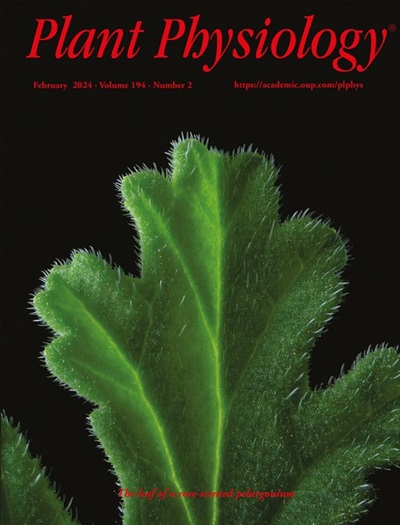拟南芥中的ASYMMETRIC LEAVES1通过光介导的叶绿素信号促进叶片下垂。
IF 6.5
1区 生物学
Q1 PLANT SCIENCES
引用次数: 0
摘要
在植物中,平衡生长和环境反应对于最大限度地提高适应能力至关重要。植物之间的接近和树冠遮荫会对繁殖产生负面影响,这主要通过光质和辅助素水平的变化引起下胚轴生长和叶片下垂等形态调整。然而,从遮荫叶片合成的辅助素如何在远端诱导下胚轴和叶柄细胞的伸长仍有待阐明。我们证明,拟南芥(Arabidopsis thaliana)中的ASYMMETRIC LEAVES1(AS1)通过调控辅助素生物合成、极性辅助素运输和辅助素信号转导基因促进叶片下伸。AS1 过表达会导致叶柄背面细胞伸长,叶柄中的辅素积累,导致叶片下垂生长,在叶片上施用辅素转运抑制剂可抑制下垂生长。此外,在遮荫条件下,as1 突变体的下胚轴生长也会减弱。我们观察到,在遮荫或远红光条件下,AS1 蛋白会在细胞核中积累。染色质免疫沉淀分析确定了 AS1 与 YUCCA8(YUC8)和 INDOLE-3-ACETIC ACID INDUCIBLE 19(IAA19)启动子的关联。此外,AS1 还与细胞核中的 PHYTOCHROME INTERACTING FACTORs 形成复合物,并协同诱导 YUC8 和 IAA19 的表达。我们的研究结果表明,AS1通过连接光和植物激素的作用,在促进表型对周围环境的可塑性方面起着至关重要的作用。本文章由计算机程序翻译,如有差异,请以英文原文为准。
ASYMMETRIC LEAVES1 promotes leaf hyponasty in Arabidopsis by light-mediated auxin signaling.
In plants, balancing growth and environmental responses is crucial for maximizing fitness. Close proximity among plants and canopy shade, which negatively impacts reproduction, elicits morphological adjustments such as hypocotyl growth and leaf hyponasty, mainly through changes in light quality and auxin levels. However, how auxin, synthesized from a shaded leaf blade, distally induces elongation of hypocotyl and petiole cells remains to be elucidated. We demonstrated that ASYMMETRIC LEAVES1 (AS1) promotes leaf hyponasty through the regulation of auxin biosynthesis, polar auxin transport, and auxin signaling genes in Arabidopsis (Arabidopsis thaliana). AS1 overexpression leads to elongation of the abaxial petiole cells with auxin accumulation in the petiole, resulting in hyponastic growth, which is abolished by the application of an auxin transport inhibitor to the leaf blade. In addition, the as1 mutant exhibits reduced hypocotyl growth under shade conditions. We observed that AS1 protein accumulates in the nucleus in response to shade or far-red light. Chromatin immunoprecipitation analysis identified the association of AS1 with the promoters of YUCCA8 (YUC8) and INDOLE-3-ACETIC ACID INDUCIBLE 19 (IAA19). In addition, AS1 forms complexes with PHYTOCHROME INTERACTING FACTORs in the nucleus and synergistically induces YUC8 and IAA19 expression. Our findings suggest that AS1 plays a crucial role in facilitating phenotypic plasticity to the surroundings by connecting light and phytohormone action.
求助全文
通过发布文献求助,成功后即可免费获取论文全文。
去求助
来源期刊

Plant Physiology
生物-植物科学
CiteScore
12.20
自引率
5.40%
发文量
535
审稿时长
2.3 months
期刊介绍:
Plant Physiology® is a distinguished and highly respected journal with a rich history dating back to its establishment in 1926. It stands as a leading international publication in the field of plant biology, covering a comprehensive range of topics from the molecular and structural aspects of plant life to systems biology and ecophysiology. Recognized as the most highly cited journal in plant sciences, Plant Physiology® is a testament to its commitment to excellence and the dissemination of groundbreaking research.
As the official publication of the American Society of Plant Biologists, Plant Physiology® upholds rigorous peer-review standards, ensuring that the scientific community receives the highest quality research. The journal releases 12 issues annually, providing a steady stream of new findings and insights to its readership.
 求助内容:
求助内容: 应助结果提醒方式:
应助结果提醒方式:


